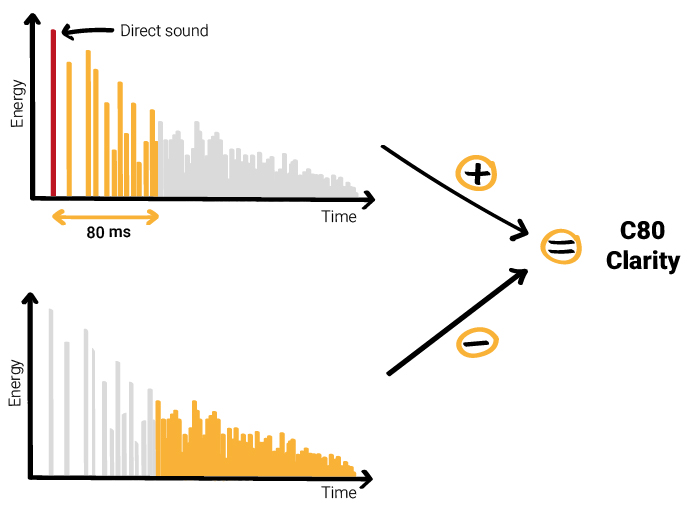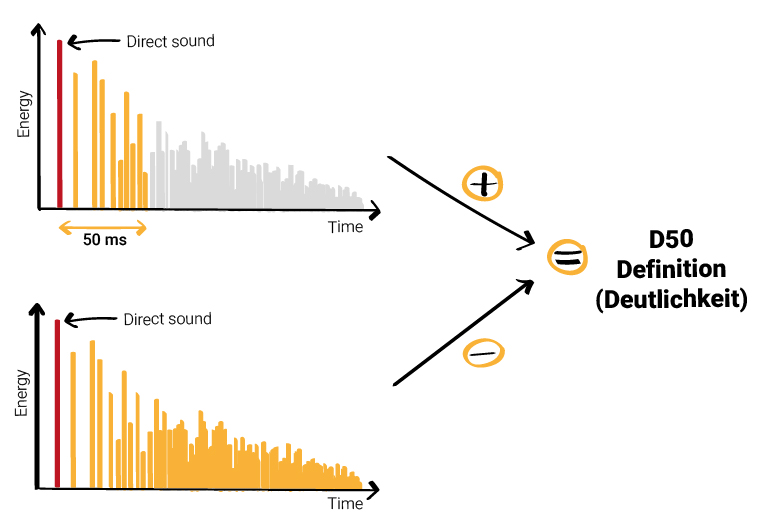
If you design a new performance space, you want to know how the musical or speech-based activities will be heard.
Or similarly, you might want to establish the acoustic conditions of an existing performance space.
As part of the assessment, you generally need to ask yourself:
- is the space going to be too dead or too live for the type of performances planned?
- are the performances going to be clear and/or intelligible to the audience?
- are performances going to sound too quiet or too loud … or just right?
- is the space (especially during musical performances) going to sound too dry or too boomy?
Part 2 here goes through some specialist acoustic indices that help to objectively answer the above questions.
These indices are:
- the Early Decay Time (EDT).
- the Sound Strength (G).
- the Objective Clarity (C80) or Definition (D50).
- the Early Lateral Fraction Energy (LF).
Rather than showing very technical data and complicated formulas, it intends to shed some light on which parts of the sound reverberation are used to assess the acoustic qualities of a space.
To better understand this section, you could read Sound reverberation – Part 1: Basics first. It explains what the sound reverberation is, how it is measured and what the reverberation time index is.
Enjoy the read!
(See at the end the references used to confirm the concepts)

Do you want to be notified when new posts are published?
Why don’t you subscribe to Atelier Crescendo’s newsletter by clicking here?
Early decay time
As its name says, the EDT is a measure of how fast (or not) the early sound energy decreases in a room. The quicker the early reverberation dies, the shorter the EDT.
Technically, it is based on measuring how long the early energy takes to decay by 10 dB (excluding the direct sound from the source).
The EDT is very often used for the (re)design of music performance venues and relates to the perception of acoustic reverberance.

In the table below, you can see some examples of preferred EDT values (in seconds) for different types of musical performances.
[table id=2 /]
You can see that the EDT values are shorter for opera performances than for chamber music and symphonic music performances.
This means that you want the early reverberation to die quicker for opera music than for chamber music and symphonic music.
Sound Strength (G)
The Sound Strength (G) relates to how loud (or quiet) sound sources might be perceived in a room. In a way, it characterises the amplification power of the room.
You can measure G using an omnidirectional sound source and compare:
- the acoustic energy of that source at a given point, against;
- he energy of the same source, located 10m away from the receiving position, in an environment with no sound reflecting surfaces (conditions found in anechoic chambers).

The sound strength is measured in dB and usually ranges between 0 and +10 dB in performance venues.
In the table below, you can see some examples of preferred values for different types of musical performances.
[table id=3 /]
What do these values tell us?
- The preferred values are mostly positive. This means spaces need to amplify the sound of performances. Which makes sense, especially for the more remote seats where you also want to hear the quieter instruments and sound details of the performances.
- The preferred ranges have different upper limits. This shows that each type of performance has its own preferred level of amplification above which music might sound too loud and unpleasant.
- The preferred values for chamber music are higher than for symphonic repertoire and for opera. This means that spaces for chamber music performances require a higher sound amplification. This makes sense because the instruments and ensembles involved in chamber music are respectively quieter and smaller than those involved in symphonic repertoire or opera.
- The values presented are averages over 500 and 1000 Hz frequency bands (i.e. mid frequencies). At low frequencies (especially around 125 Hz), for symphonic music, the sound strength is preferred to range slightly higher between 3.0 and 6.0 dB. This corresponds to a preference for rather warm reverberation conditions that amplify the base sounds more than the medium sounds.
Objective Clarity (C80) and Definition (D50)
Whilst the objective Clarity (C80) helps to assess the clarity of musical performances in a space, the Definition (D50, also called Deutlichkeit) is for the intelligibility of speech-based performances.
Both metrics are based on comparing early sound energy against the late or total sound energy arriving at a listening position.
Note: Musical clarity corresponds to the ability to hear the musical details.
Both metrics are based on comparing early sound energy against the late or total sound energy arriving at a listening position.
For the C80, you compare the energy arriving within the first 80 ms against the rest of the energy.

The Clarity is measured in dB.
For the D50, you compare the energy arriving within the first 50 ms against the total of the energy.

Note: The average duration of speech sounds is around approximately 70 ms.
The Definition has no unit and the preferred values range between 0.3 and 0.7.
What do these values tell us?
- The ranges imply that a balance is desired between the early energy and the total or rest of the energy.
- The more the early energy, the higher the values, the clearer the speech/musical messages.
- The C80 values for Opera performances are higher than the preferred values for chamber music and symphonic music. This translates the need for more reflected sound arriving early to the listeners. This makes sense as enjoying opera performances depends on clearly understanding the musical and sung messages.
- In comparison, the preferred values are lower for symphonic music, meaning that hearing every single musical detail is not as important and blending of musical sounds is more preferable.
Early Lateral Fraction energy (LF)
The Early Lateral Fraction energy (LF), also called the objective source broadening, considers some spatial aspects of the sound reverberation.
The metric is an objective measure of two spatial impressions:
- a sound source becoming broader to a listener as it becomes louder.
- the sound surrounding a listener, giving a sense of envelopment
For musical performances, the perceived broadening of a sound source and the envelopment are both desired to create a sense of spaciousness. This is largely influenced by early reflections arriving in lateral directions to a listener.
Hence why you calculate LF by comparing, within the first 80 ms, the sound energy arriving to the sides against the sound energy arriving in all directions.

The early lateral fraction energy has no unit. It is averaged from 125 Hz and 1000 Hz and it is generally preferred to range between 0.05 and 0.35.
Other acoustic indices
Other important indices not mentioned above are:
- Speech Transmission Index (STI): It measures the intelligibility of speech-based messages and is very often used to design Public Address Voice Alarm (PAVA) systems. Calculating the STI in a space at a specific location is complex. It depends on the speech level, the frequency content of the message, the background noise level in the space, the quality of the audio equipment and also the sound reverberation in the room;
- Early Support (STearly) and Late Support (STlate): They are two measures of the acoustic conditions for music ensembles and concentrates on the very early sound reverberation. Stage acoustic science (based on the acoustic conditions musicians prefer to play in) has recently seen extensive progress thanks to the development of new audio reproduction techniques and computer modelling. Focus has been on the spatial and spectral (i.e. frequency related) aspects of the reverberation on stages.
Conclusion on acoustic design
As discussed above, one key design aspect for performance venues is to study the way sound is reverberated inside.
For different listening positions, the acoustic designer works on:
- controlling how fast the reverberated sound energy decreases within the space.
- managing the natural sound amplification of the space depending on the music played.
- controlling the frequency content of the reverberated sound.
- finding the right balance between the early and late sound energies arriving at the listening positions.
- controlling the directions in which the (early) sound energy arrives at the listening positions.
All the above mainly depend on the location and shape of the surfaces within the space, the volume of the space and the acoustic properties of the finishes.
Acoustic references
See below the references used to confirm the above concepts:
-
Auditorium Acoustics and Architectural Design – Mike Barron;
-
Concert halls and Opera Houses – Music, Acoustics and Architecture – Leo Beranek
-
ISO 3382-1: 2009 – Acoustics — Measurement of room acoustic parameters — Part 1: Performance spaces
